A couple years ago, I wrote all about Mesa Verde based on my visit to this fascinating park back in 2010. But Pat had never been there and it’s a place I was happy to return to, so in early July of last year we headed out for a week long exploration of southwestern Colorado, including 2.5 days at Mesa Verde. Since my previous posts were written based on what I could remember many years after the fact (which, it turns out, wasn’t much), I’ve decided to heavily edit them and add in new information and photos and share them with you again here.
Mesa Verde – Spanish for “green table” – probably conjures up images of a giant plateau topped with luscious greenery. From a distance, that is in fact what Mesa Verde looks like. Up close, that’s pretty much what it looks like as well. Geologically speaking, though, Mesa Verde isn’t a mesa. It’s technically a cuesta, which is a plateau that isn’t quite horizontal. In this case, Mesa Verde is tilted 7% to the south, which makes it sunnier and more optimal for farming than the land down below. This is thought to be at least one of the reasons why Mesa Verde was historically such a populated area.
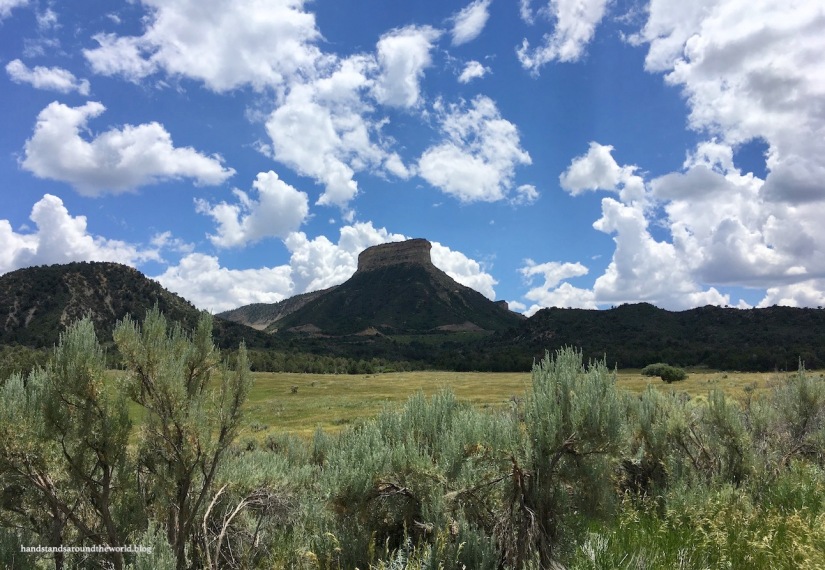
Here at Mesa Verde National Park, thousands of years of history is preserved in the cliff faces and stone remains left behind by ancient peoples. Because of this, Mesa Verde has been designated as a United Nations World Heritage Site. The park contains over 4,000 well-preserved archaeological sites, including the largest known cliff dwelling in North America.
Mesa Verde and the surrounding area has been inhabited since ~9500 BC by various Native American lineages, though archaeological evidence of their presence in the region is limited due to their nomadic lifestyles. By 550 AD, it was primarily the Ancestral Puebloan peoples who lived in the area and built the many cliff dwellings and other structures that remain today.
All evidence suggests that they left by the end of the 13th century; archaeologists have hypothesized drought, declining resources, and social or political concerns as possible explanations for their southward migration. Modern day Puebloans, however, simply say that their ancestors left because it was time to move on.
One important point before I go any further: you will sometimes hear the Ancestral Puebloans called the Anasazi. However, “Anasazi” is actually a Navajo word meaning “ancient enemy;” for obvious reasons, present day Puebloans have asked that this word not be used.
Mesa Verde is located in the southwestern corner of Colorado near the city of Cortez. It’s an oddly-shaped park, with just one entrance station and winding, narrow roads. Travel through the park takes longer than you’d expect, and trailers and large vehicles (i.e. RVs) aren’t allowed past the campground.
Upon arrival, our first stop was the Visitor Center which is the main place to purchase tickets for tours of the cliff dwellings. Tickets are $5/person per tour and they usually sell out by the end of the day. However, they can be purchased up to two days in advance. Using this strategy, Pat and I managed to secure tickets for all three tours!
Update: beginning in the 2020 season, tickets can now be reserved in advance on recreation.gov for $7/person. Some tickets are still sold in person at the visitor center, but supplies are limited.
Our second stop was Morefield Campground, located 4 miles (6.4 km) up the road from the Visitor Center. Morefield Campground is… fine. It has showers, coin op laundry, and a small camp store. The showers are free, although the three (yes, three) signs in each stall asking people not to poop in the shower made me seriously consider not showering.
The campground accepts reservations, though it didn’t even come close to filling. Also, I’m not really sure you gain anything from reserving because you don’t get to pick a site in advance. You just check in and they tell you to choose any open site. We initially chose a sunny site that offered some views. This lasted about 2 hours, at which time we carried our tent across the road into a shady site. July sun at 7700 feet (2350 m) of elevation is no joke; I’d recommend prioritizing shade over views. I’d also recommend arriving by mid-afternoon, particularly if you’re a tent camper, as the shady sites are the first to fill.
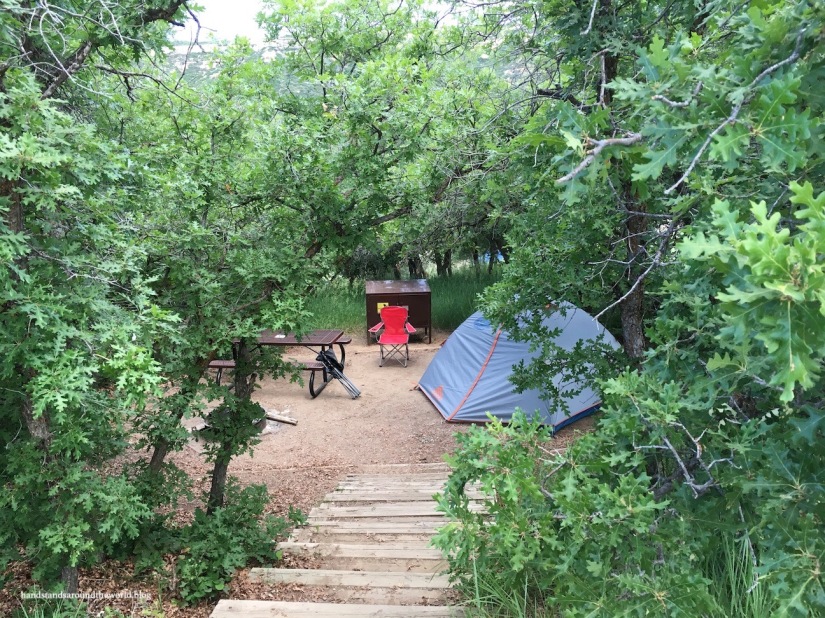

Beyond the campground, the road travels through a tunnel and then begins winding its way along the mesa. I was under the impression that the top of the mesa would be flat, but that’s very much not the case. Mesa Verde is actually topped with numerous smaller finger mesas, and navigating them means lots of ups and downs and curves.
There are several overlooks along the way, with short walks out to viewpoints. From some of these overlooks, views extend into Colorado, Utah, New Mexico, and Arizona!
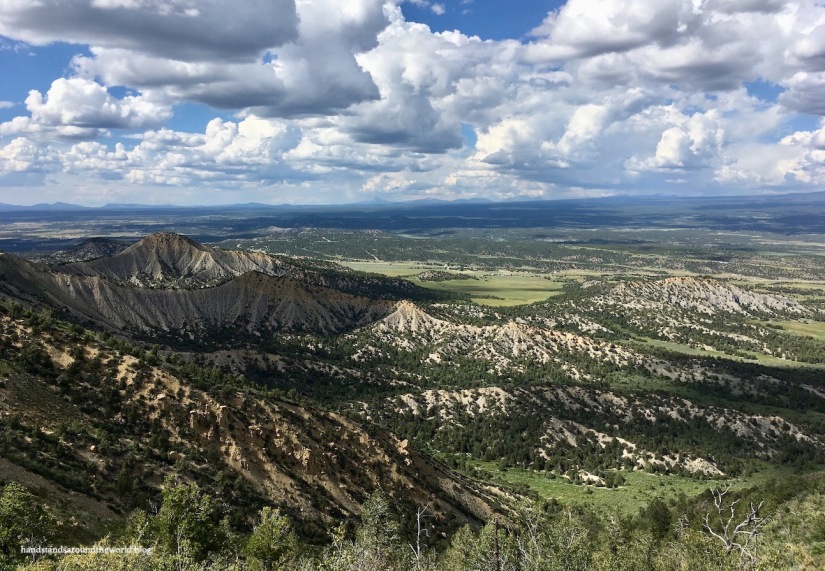
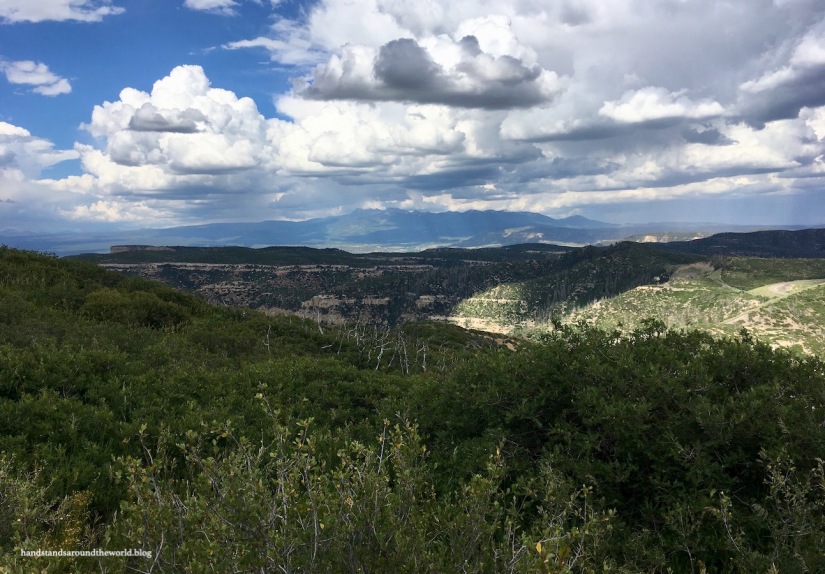

Eleven miles (17.7 km) beyond the campground is Far View Junction. From here, the road forks; right leads to Wetherill Mesa and left to Chapin Mesa. Today, we’re going to go right. The Wetherill Mesa road is only 12 miles (19.3 km) long, but it takes 45 minutes to drive due to the abundance of sharp curves. I remember reading that and assuming it was an exaggeration. It was not.
The road comes to an end at the Wetherill Mesa parking area and kiosk. From here, the paved 6 mile (9.6 km) Long House Loop Trail leads out onto the mesa. Wetherill Mesa is the lesser visited half of the park, likely a combination of the long winding road and the fact that, if you want to see anything here, you have to do some hiking. We didn’t mind, though. It was nice to escape the traffic and the crowds.

Long House is one of the cliff dwellings that can only be visited as part of a ranger-led tour; beware that tickets cannot be purchased on Wetherill Mesa. The Long House tour is about 2 hours long and involves a 2.25 mile (3.6 km) round trip hike with 130 feet (40 m) of elevation gain. The tour also includes a climb up two 15 foot (4.5 m) ladders.
As with all the Mesa Verde cliff dwellings, Long House was built during the AD 1200s. It’s the second-largest cliff dwelling in Mesa Verde; it’s estimated that approximately 70 people lived here.
One of the commonly asked questions about the cliff dwellings is: why here? These weren’t necessarily easy places to live. The alcoves did provide some shelter from the elements, but farming was occurring on top of the mesa and hunting and water collection weren’t things that could happen from the alcoves either. However, Long House contains a large seep spring on the back wall, removing one of these challenges. Also, its orientation is such that it remains mostly shaded in the summer but receives sunlight in the winter.


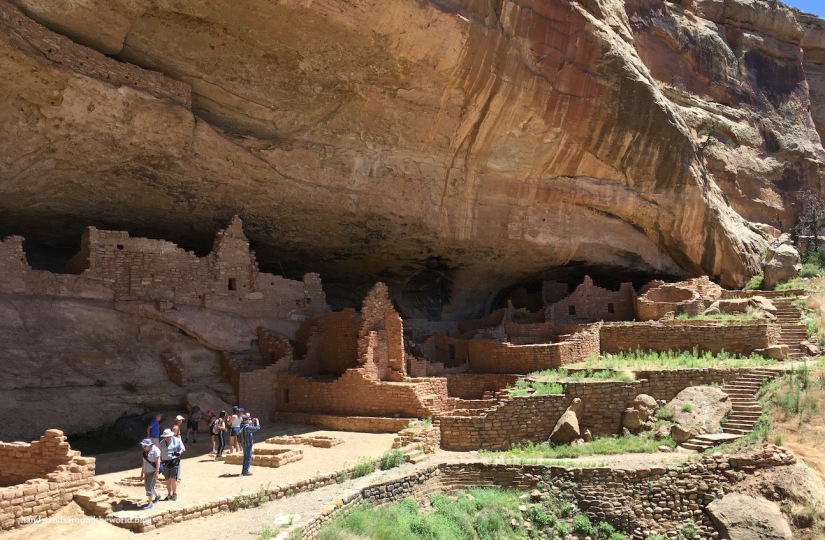
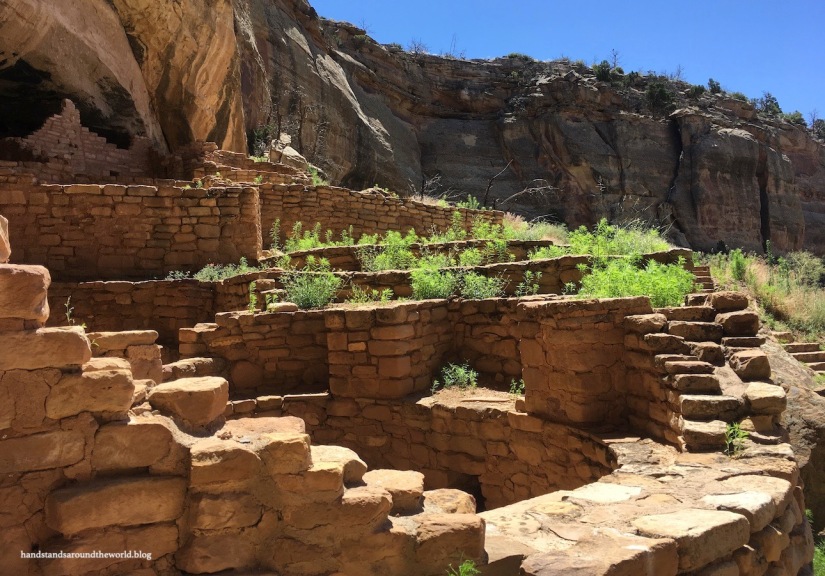
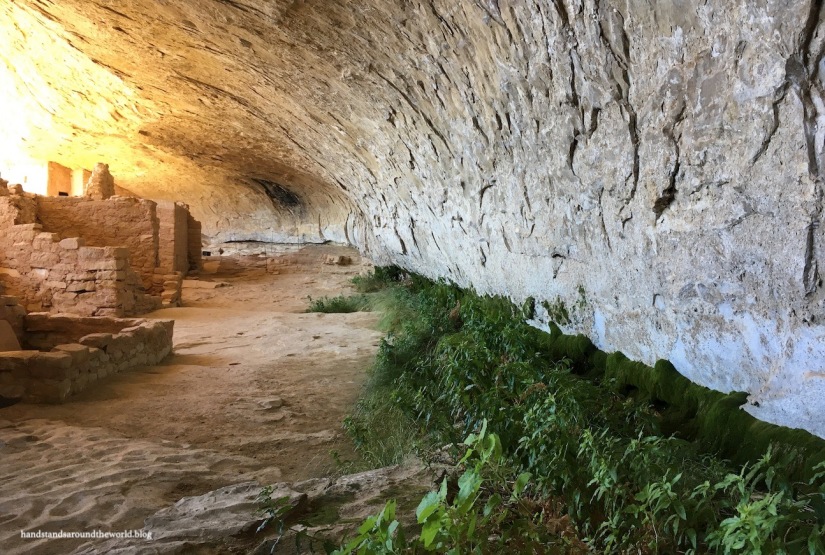
Another question you will hear quite frequently in Mesa Verde is: what is a kiva? A kiva is a round room found at every single site we saw in Mesa Verde, as well as in present day pueblos. In the Hopi language, “kiva” translates to “room underneath.”
A kiva is built with a very particular design and always has 6 pilasters (rock columns) for support for the roof, a fire pit in the middle of the floor, and a small hole in the floor called a sipapu, which is believed to be where the spirits of their ancestors entered the world. The sipapu and fire pit are always lined up with a ventilation shaft, facing south. Air is pulled into the ventilation shaft and hits a specially placed deflector wall which serves to mix the cold outside air with the internal fire heated air.
Though the kivas in Long House have been excavated, they would have also included a roof with a hole for smoke to escape and for entry into the kiva by ladder.
Kivas are primarily used for ceremonial purposes, but archaeological evidence and present day Puebloan accounts also indicate that kivas were used for education, other daily activities, and, at times, as a living space.
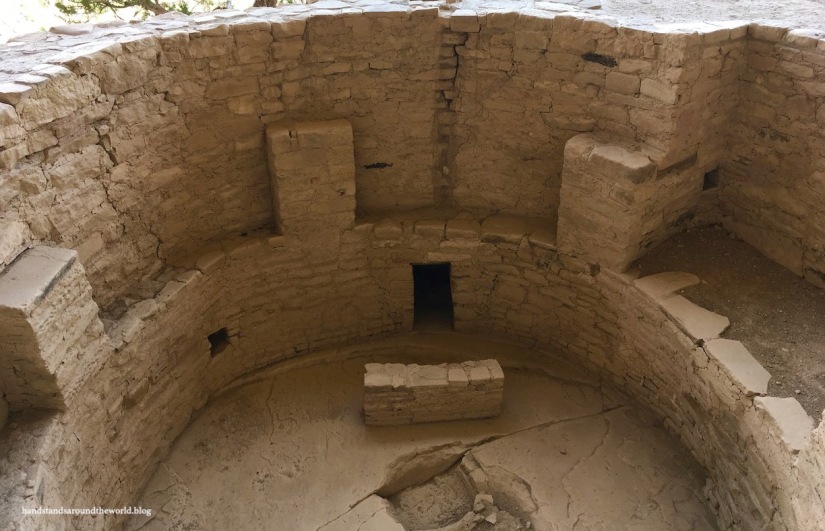
While many of the cliff dwellings share similar features, Long House is the only one where we saw a great kiva. This is the wide open area at the front of the dwelling, likely designed for celebrations and dances. Remains of rock structures on the great kiva floor are thought to be for foot drums, over which hides were stretched to form the instrument. The echo properties of the canyon walls surrounding Long House mean that sounds of such ceremonies and celebrations would be heard from a good distance away.

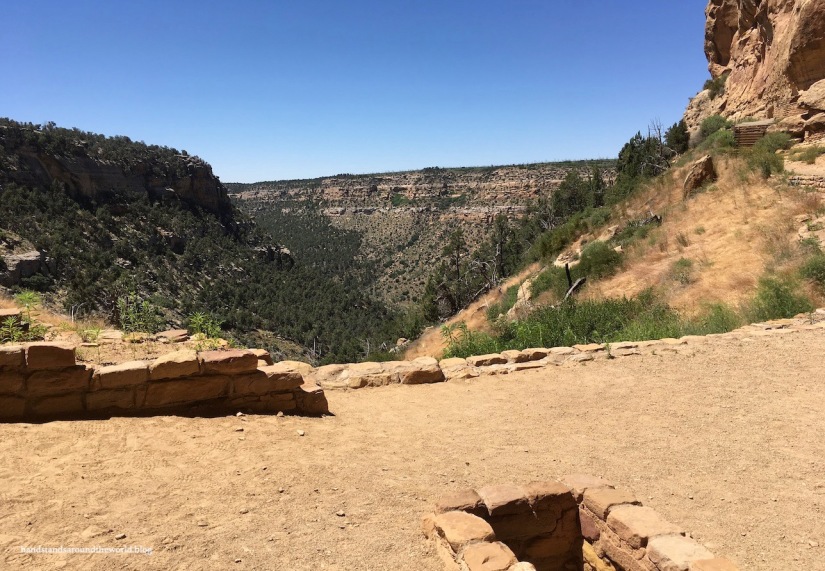
The Long House tour ends back at the Long House trailhead, from which you can return to the kiosk or continue around the Long House Loop. Pat and I opted to continue and complete a portion of the loop, beginning with a 1 mile (1.6 km) walk through the Badger House Community Sites. These four sets of ruins are located not in an alcove, but on top of the mesa.
Although Mesa Verde is predominately known for its cliff dwellings, Ancestral Puebloans only built and occupied these dwellings for about 80 years. Prior to this, they lived on top of the mesa from approximately 550-1175 AD. The Badger House Community Sites includes the Basketmaker Pithouses, Pueblo Village, Badger House, and Two Raven House.
The Basketmaker era refers to the period of time from 500-600 AD when pottery was not yet used by the Ancestral Puebloans. However, very intricate and functional woven baskets were used for everything from storing water to cooking. Meanwhile, a Pithouse is a style of dwelling that involved digging down into the ground to form the basic foundation and lining it with a row of stone slabs. Next, wooden walls were erected, woven together with branches, and subsequently coated in mud plaster. This wood/clay method of architecture is called jacal (ha-CALL).
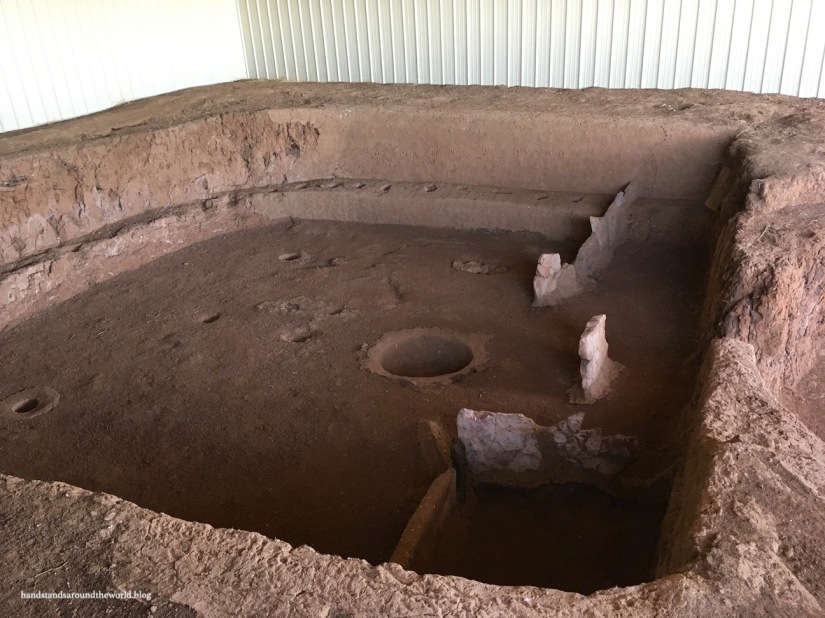
Moving forward in the archaeological record to about 1000 AD, pithouses evolved into pueblos, which were villages built from the ground up using rocks rather than jacal. Some of these pueblos are very extensive and are found throughout Mesa Verde. Pueblo Village is unique for the discovery of an older kiva beneath the pueblo walls, suggesting that newer structures were built on the remnants of a prior living site.
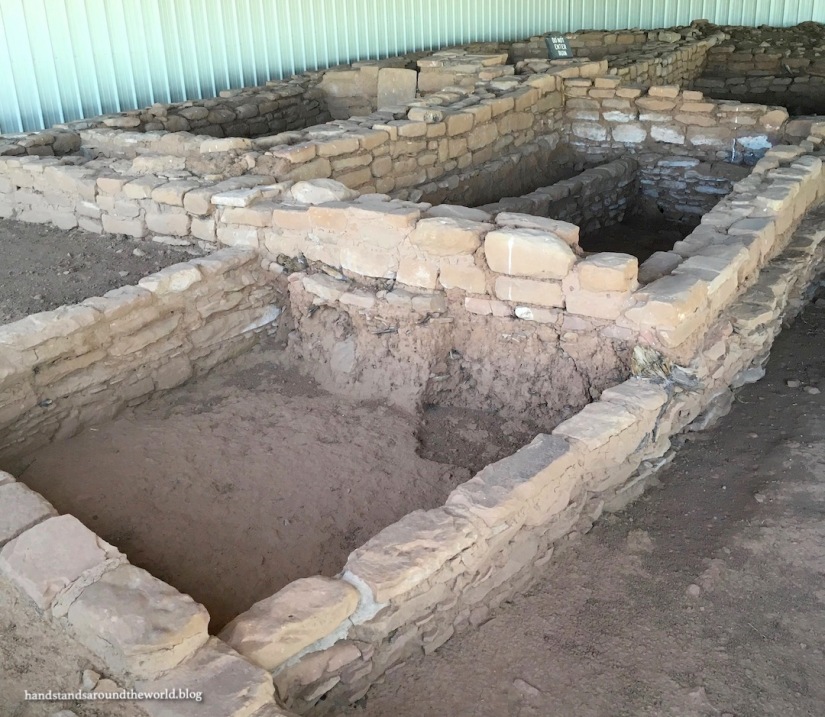
Badger House depicts a similar phenomenon, with the older pueblo dwelling units built with just one layer of rock while later pueblo construction (approx. 1075 AD) included double layered rock walls that would have been much more stable.
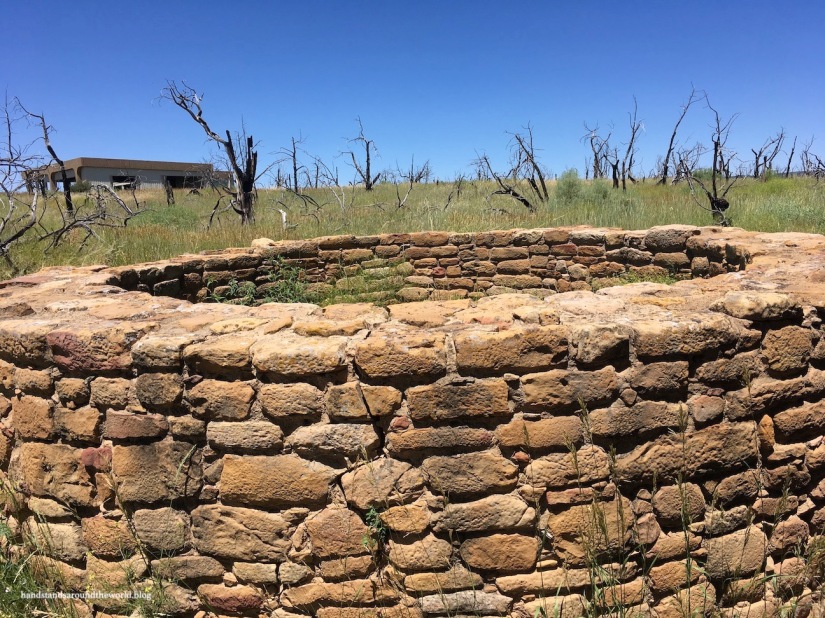
Lastly, Two Raven House is a fairly well preserved example of these mesa top pueblos.
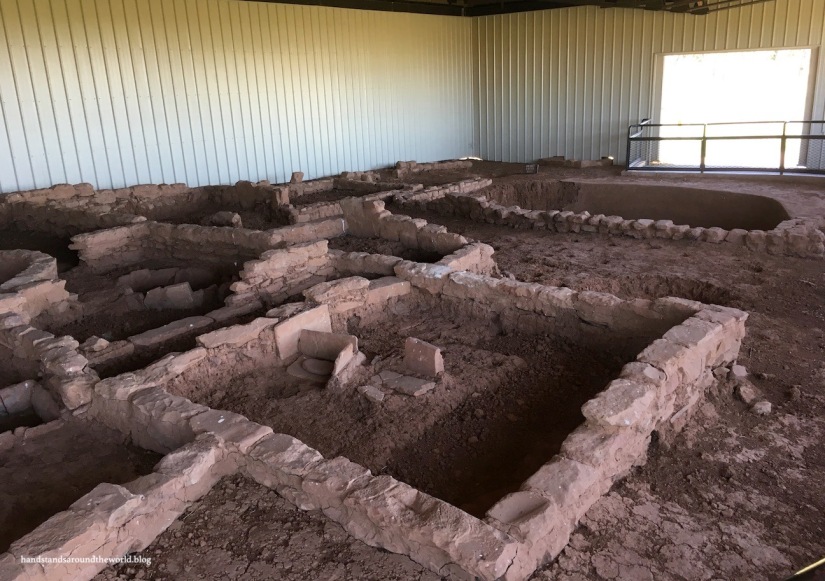
After completing the Badger House loop, we took the 1 mile (1.6 km) round trip hike out to a viewpoint of Nordenskiöld Site #16, a small cliff dwelling. This site is named for Swedish scientist Gustaf Nordenskiöld (pronounced NOR-den-shold), who was the first scientist to visit Mesa Verde. His methods of study were considered very good at the time, and his publications and photographs were very thorough. However, his work raised much controversy, as he took many artifacts back to Sweden with him. His actions spurred the passing of the Antiquities Act and the designation of Mesa Verde as a national park in 1906, thereby preventing further removal of artifacts from the sites.
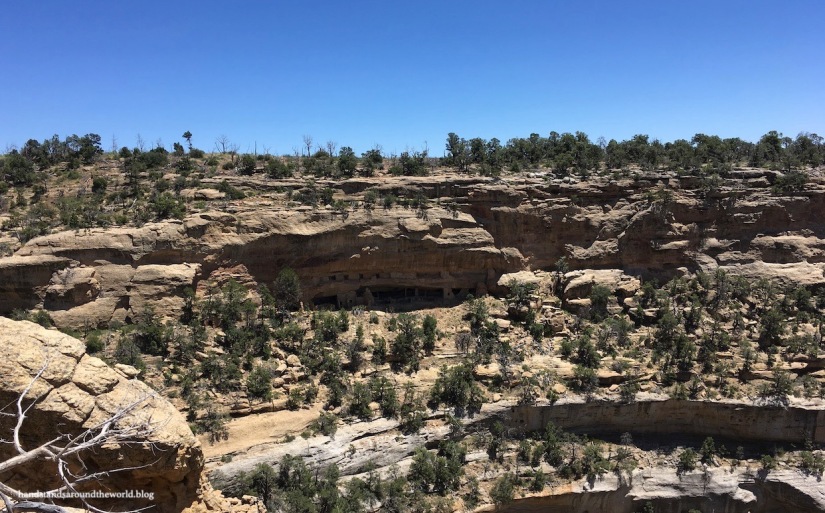
After returning to the parking lot, Pat and I completed one final hike on Wetherill Mesa: Step House. This cliff dwelling can be visited on your own for free and requires only a 1 mile (1.6 km) round trip hike. Step House is interesting because half of the ruins are similar to the pit houses typically found on the mesa top while the other half represents a fairly typical cliff dwelling. You can view a partially-reconstructed pithouse here, complete with a roof. There are also a few petroglyphs at Step House.

And this concludes our exploration of Wetherill Mesa. Up next week: the other half of Mesa Verde and lots more historical and archaeological fun facts!
The Important Stuff:
- Getting there: Mesa Verde is located off of US Highway 160 in the southwest corner of Colorado; to get to the areas discussed in this post, follow the park road to the fork, then keep right onto Wetherill Mesa Road
- Fees and passes:
- Entry to the park costs $25 per car for a 7-day pass; interagency annual passes are accepted. Visiting the cliff dwellings requires a guided tour reservation, which range in cost from $5-$45/person depending on the tour (there are short tours, full-day tours, and backcountry tours). Tickets are available in advance. More info can be found here
- Hiking: in addition to the cliff dwelling tours, there are many lesser traveled hiking options in Mesa Verde
- Where to stay: Morefield Campground – 267 sites, reservations accepted but the campground rarely fills, $30+ tax per night. Far View Lodge is open April-October and is the only non-camping option in the park
- Other: food can be found throughout the park, but there is no gas beyond Morefield Village. Also, any vehicle over 8000 lbs (3600 kg) or 25 feet (7.6 m) long is not allowed on Wetherill Mesa.




Glad I found your posts on Mesa Verde! I had no idea that the word “Anasazi” would actually be an insulting term to reference the Puebloans, but now I know! I was also under the impression that one can access the houses on our own, but I suppose selected houses must require tours? I appreciate your detailed advice, and I hope to use them when I go!
LikeLiked by 1 person
why did they move from the mesa top to the cliff dwellings?
LikeLike
Because it was more sheltered and protected from the elements, and once they learned how to build up from the ground with rocks they were then able to construct the dwellings.
LikeLike
Thank you for sharing all of this amazing information!! Your sunset photo is to die for btw! I really love Mesa Verde such a hidden gem.
LikeLiked by 1 person
Thanks for the post. We went to Mesa Verde this summer and it is one of our favorite national parks. Albuquerque and Santa Fe also helped to make it a great road trip in addition to Great Sand Dunes National Park. Did I miss a picture of the handstand??
LikeLiked by 1 person
Ah yes, I haven’t made it to Albuquerque or Santa Fe yet… or most of New Mexico, for that matter. So much left to explore.
Now that you mention it, I don’t think I’ve done a handstand in Mesa Verde. I don’t always do one, especially if there are a ton of people or there’s not a good spot for one.
LikeLiked by 1 person
Really interesting post. I was there as a kid and always wanted to go back. About two years ago we were in Durango for several days as part of a long road trip. We’d planned to see Mesa Verde, but logistically it just didn’t work out, largely because we were pulling a trailer and didn’t want to fuss with all the unhooking in the park’s parking lot, etc. We will get back out there again, though, and next time we WILL see it!
LikeLiked by 1 person
I hope you get to visit it soon! Also, there’s a campground just inside the park and I believe we passed one just outside the park as well, so that might make the trailer logistics a little easier to manage (but I’ve never owned one so I may have no idea what I’m talking about…)
LikeLiked by 1 person
You’re right – that might make a huge difference. If we camped there for a couple of days, we’d unhook the car anyway. Great idea – thank you!
LikeLiked by 1 person
I’ve long wanted to visit this national park. Your description is so thorough and I really appreciate how much time and effort this level of detail requires. It was cool to read about Mesa Verde not really being a mesa and how a slight angle can make such a difference for farming.
LikeLiked by 1 person
Thanks! The other half of my very long-winded summary is queued to post tonight.
LikeLike
Awesome – this park has been on my list for awhile, these pics are an amazing glimpse at it!
LikeLiked by 1 person
And yet the pictures can’t fully capture the complexity and ingenuity. I hope you get to visit after all this craziness dies down!
LikeLiked by 1 person
Oh yes, I imagine we’ll be taking LOTS of trips when the crazy dies down 🙂
LikeLiked by 1 person
Lots of great info! Haven’t been yet, but on my list. Bookmarking this post for sure, thanks.
LikeLiked by 1 person
Glad to be useful! I was worried this one was a little too long a detailed
LikeLike
Great post! I can’t wait to go back here, haven’t been since I was 12-14 or so!
LikeLike
I imagine adult you will have a very different experience than teenage you did haha! It’s such a fascinating place!
LikeLike
Yeah I’d probably appreciate it more! Haha
LikeLiked by 1 person